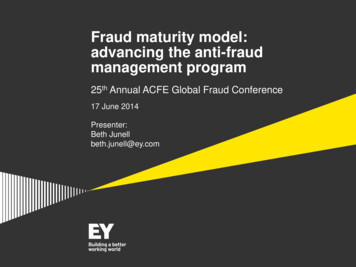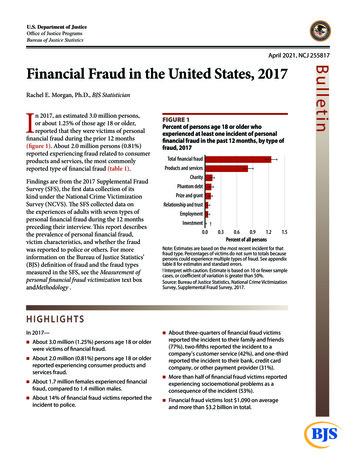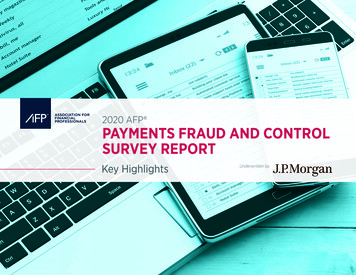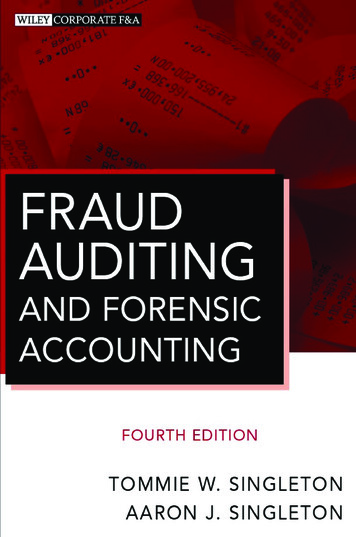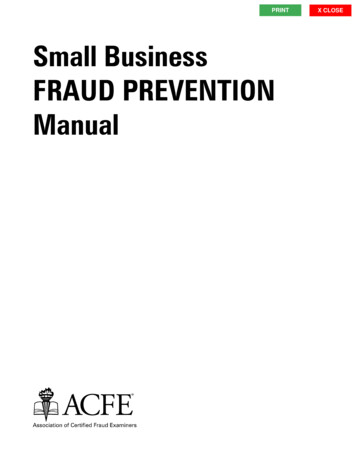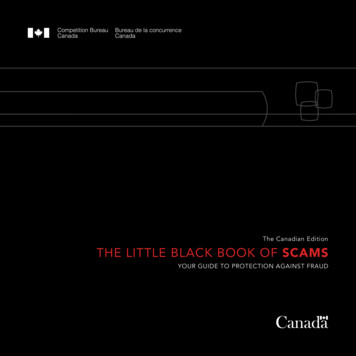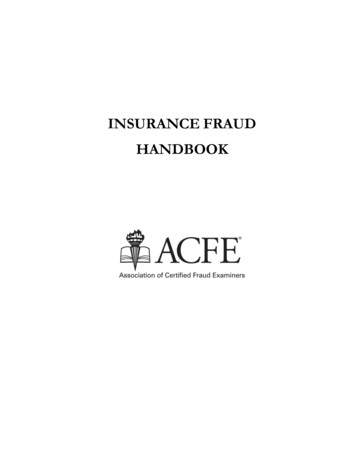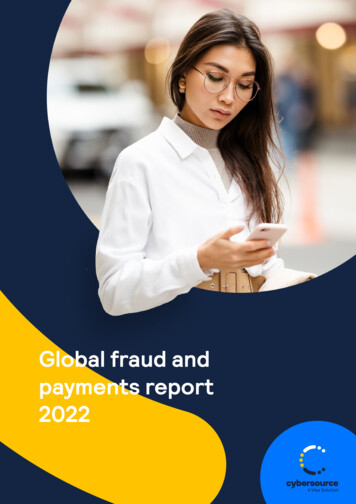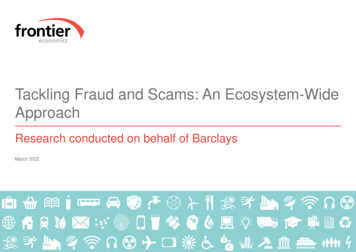
Transcription
Tackling Fraud and Scams: An Ecosystem-WideApproachResearch conducted on behalf of BarclaysMarch 2022
Barclays Foreword (1/2)The UK is in the midst of a scams epidemic, with devastatingconsequences for individuals, businesses and the economyas a whole.More and more of our lives are digital, from working andsocialising to gaming and dating – that trend has long beenevident, and has been accelerated by Covid-19. Butcriminals are adapting to take advantage of this and defraudinnocent victims, with 2021 expected to have been a recordyear for the number of financial scams, with victims losingmore to fraudsters than ever before.Retail banks have taken a number of steps in anticipation ofand response to these developments, including voluntarilyintroducing the Contingent Reimbursement Model (CRM)Code, which guarantees that victims will be reimbursed ifthey have taken reasonable steps to protect themselvesagainst the possibility of a scam.Scams can have life changing impacts on their victims, andthose innocent people deserve a mechanism through whichto be reimbursed. But reimbursing customers does not – andwill not – fix the fundamental problem we all face. The simplefact is that criminals still benefit from the proceeds of theircrime, which are then reinvested in creating even moresubtle ways of defrauding other innocent people. This is apernicious and vicious cycle that must be broken. Thechallenge also runs deeper – public trust in the digitaleconomy is being eroded; and the emotional and mentalhealth impacts on victims are long lasting, even when theirfrontier iseconomicsmoneyreturned.The challenge facing society today, therefore, is how toprevent scams from happening in the first place. An ongoingproblem is not resolved by continually repairing its negativeimpacts, but by tackling the underlying causes and enablers.In other words, we must focus on finding the right cure, notjust treating the symptoms.That challenge seems self-evident, so the question we askourselves repeatedly is “why isn’t it getting more attention?”.I see two key reasons: first, ‘scams’ - where the victimvoluntarily and unwittingly makes a payment to a criminal –are far more complex to detect and prevent than ‘fraud’ –where the victim does not authorise the payment. With fraud,banks can use transactional monitoring capabilities to detectand stop most unusual activity. But with scams it is thelegitimate customer making a payment, which means it is notjust a question of detecting unusual behaviour, but often thenconvincing the customer to change their mind, after they’vebeen convinced by the fraudster that the action is in theirbest interest.Second, the challenge of scams cannot be solved by oneorganisation or even industry acting on its own. Criminalsexplicitly and purposely exploit multiple technologies andinfrastructures across a variety of industries because theyknow how hard it is for actors across those sectors tocoordinate their activity.It will only be through collective, coordinated intervention,from all those with the ability and need to take action, that2wecan succeed against these criminals. All relevant actors –
Barclays Foreword (2/2)government, regulators, law enforcement and key sectorsacross the ‘scams ecosystem’ (including payment providers,telecommunications firms, technology platforms, and others),along with customers – must come together as part of acomprehensive, collaborative national effort to tackle thisshared problem, prevent scams at their source and –ultimately – protect consumers and society.Recent years have seen a range of innovative andcollaborative responses to this challenge. These include: anambitious retail banking sector-wide strategy to tackle andprevent fraud and scams, coordinated by UK telecommunications firms and technology platforms; as wellas cross-sectoral efforts such as Stop Scams UK (SSUK)and the Online Fraud Steering Group (OFSG).steps required to significantly enhance how the UK as awhole responds to scams and protects society, building onrecommendations others have made.Barclays is wholeheartedly committed to playing our part inthe solution, and working constructively with all parties tostamp out the scourge of scams in the UK.We hope that these recommendations accelerate the UK’sresponse to this scams epidemic and enable a decisive newphase in tackling economic criminals before they can evenreach their potential victims.A number of governmental and regulatory initiatives havealso served to enhance the policy framework firms operate in– for example, Government’s expansion of the Online SafetyBill to include fraud, and its commitment to treat fraud as a‘priority illegal offence’. These represent welcomedevelopments that should be supported and accelerated.In order to build on these initiatives, and determine wherefurther and greater action is required, we asked FrontierEconomics to speak with experts from across the ‘scamsecosystem’ to devise a policy framework setting out what atruly comprehensive response would look like. We have thentakentheirresearch and put forward nine recommendationsfrontiereconomics– our ‘Scams Manifesto’ – that we believe are the necessaryMatt HammersteinCEO, Barclays UK3
Barclays’ Scams Manifesto makes nine recommendations foractions, based on Frontier’s research (1/2)RecommendationA single Government entity or appointed individual should bedesignated as the ‘Scams Lead’ to align Government, regulatorsand industries’ responses to tackling scams, with definedresponsibility to drive meaningful change in legislative, regulatoryand firms’ strategies.Appointment of a single entity or individual tasked withdelivering a comprehensive response to tacklingscams that aligns the activity of different policymakers, regulators and industries.2Legislative, regulatory and industry actions to tackle scamsshould be aligned by a single overarching framework (led by theScams Lead).Delivery of a framework that provides acomprehensive response to tackling scams (byaligning existing activity of different policy makers,regulators and industries, highlighting gaps thatrequire further action, and setting clear responsibilitieson designated entities to take action).3Where voluntary industry action is insufficient, gaps in theprevention of scams should be resolved through mandatedlegislative or regulatory intervention.Government and regulators make timely interventionsacross the ecosystem to require or enable action toprevent scams.4Customers should be guaranteed consistent protections fromscams from all payment providers.All Payment Service Providers (PSPs) implement therequirements of the Contingent Reimbursement Model(CRM) Code, enhancing the prevention and detectionof scams, and aligning reimbursement approaches.Data on the extent to which scams are enabled by or take placeon different platforms should be regularly publishedScams ecosystem participants publish regular data onscam activity on their platform. There is clear visibilityacross the ecosystem where scams are occurring,enabling policymakers and industries to nforcement5frontier economicsSuccess measure4
Barclays’ Scams Manifesto makes nine recommendations foractions, based on Frontier’s research (2/2)Recommendation6More scams should be stopped at source by increasingpreventative interventions across the scams ecosystem, enabledby cross-sectoral intelligence and information sharing systems.A new cross-sectoral data/intelligence sharingframework is created, providing all parties with aclearer understanding of ecosystem vulnerabilities andinforming preventative action.7Payment providers should enhance their abilities to detectscams before they take place by establishing real-time datasharing mechanisms.Payment providers are enabled (including wherenecessary through change in legislation andregulation) to make more targeted and impactfulinterventions to stop scams from succeeding, whileallowing legitimate payments to continue unhindered.8People should be given better and more regular guidance andeducation on the risks of scams, delivered by a coordinated,comprehensive and ongoing education and awareness campaign.A single unified education campaign on the dangers ofscams, and how people can best protect themselvesis designed and delivered across sectors of the scamsecosystem. Metrics of customer understandingincrease.9People who fall victim to scams, but who have undertakenadequate due diligence, should be reimbursed, funded on the‘polluter pays’ principle.The creation of a central “ecosystem” funding pot,funded by firms in the scams ecosystem relative to theextent that they enable scams to take place.Data ontier economicsSuccess measure5
Frontier Executive Summary (1/2)Financialscams are alarge andgrowingproblem inthe UK Financial scams in the UK have risen to become a significant problem, and one beset bychallenges in tackling, including; the international nature of fraud and scams, continually evolvingfraudster tactics, and difficulties engaging consumers and stakeholders to take action. The problem is getting worse, with authorised push payment (APP) scams increasingly common. Thistype of scam involves convincing victims to make payments to accounts controlled by a fraudster. In2020, APP scam losses reached a record high. In addition to financial losses, victims tend toexperience a range of additional emotional harms. As economic activity continues to move online, digital channels have become the main channelthrough which contact with victims takes place, although other channels – particularly Telecoms continue to be important. involvinga wide rangeof sectors While scams ultimately involve a payment being made, the success of a scam relies on findingvictims, gaining their trust, and convincing them to make the payments. Fraudsters have developed sophisticated techniques to gain trust and trick victims. These interactionstend to happen over a prolonged period of time and involve multiple sectors in a wider ‘scamsecosystem’. Criminals evolve their tactics to target the weakest link in the chain, and exploit vulnerabilities whereverthese arise. No single action or sector will reduce or eliminate fraudulent activity through actingalone.To understand different perspectives on the key problems and potential actions that would make a difference,Frontier interviewed 17 senior individuals from organisations across the scams landscape.frontier economics6
Frontier Executive Summary (2/2)Thoseinterviewedcalled formore centralleadership Those interviewed suggested that while much has been done to date to tackle scams, in theabsence of a different approach scams levels will continue to rise. Stakeholders believe the key to this new approach will be greater central leadership to prioritise,standardise and drive the large number of actions being taken, to facilitate greater informationsharing and better data analytics, increase the urgency of actions through building even greaterpolitical support, and coordinating consumer messaging to make it more effective.Stakeholderviewsindicate anew policyframeworkshould drivegreatercrosssectoralactionacross fiveareas1. Data sharing. Those interviewed suggested more effective data and information sharing within andacross industries is required to improve identification, prevention, and disruption of killchains.2. Regulation and enforcement. Stakeholders see a continued important role for regulators andenforcement agencies to coordinate sectoral activities, and remove barriers to effective collaborativeactions, where these arise.3. Technology. Stakeholders were clear that all sectors should continue to invest to improve systemsecurity, improve detection and prevention, and aid enforcement activity.4. Education. The view of those interviewed was that better joined-up cross-sector efforts to improvemessaging would improve engagement, and be more effective in providing individuals with the skillsand confidence to spot scams and avoid becoming victims.5. Victim support. Stakeholders believe that all sectors have a role to ensure financial compensationprocesses work to support victims, and should continue to find better ways to provide greateremotional support for victims of financial scams.frontier economics7
1.The growing problem of scams2.The scams ecosystem133.Views from the ecosystem on what more can be done174.Barclays’ Scams Manifesto21frontier economics98
The Growing Problem of ScamsFraud (including scams) is the most prevalent type of crime in the UK While good progress has been made on tackling‘unauthorised’ fraud, criminals have turned their focustowards ‘authorised push payment fraud’, otherwiseknown as (and referred to throughout as) scams (see box). A number of issues make tackling scams challenging: There is a strong international element to the activities:criminal gangs tend not to be based in the UK, andfunds that are successfully defrauded are typicallymoved quickly offshore. This means prevention and enforcement measuresrequire significant time and resources: tracking fundsoutside UK payment systems is more challenging, andthere are added complexities involved in internationalinvestigations. Given the potential rewards involved, criminals havestrong incentives to engage in the activity, andcontinually evolve their processes and scams in orderto evade the controls and law enforcement activitiesdesigned to protect individuals. Scammers often exploit behavioural biases, making itdifficult for consumers to recognise a scam. Engagingconsumers around the issue of financial scams is thereforechallenging, with consumers often only considering risksafter they have fallen victim.frontier economicsFraud (inc. scams) has the highest incidence of any type of crime inthe UK, more than double the incidence of the next highest categories.Incidence per 1000 population The UK is generally considered to have become a globalcentre for financial fraud (including scams). As an Englishspeaking country with a highly digital population, an ageingdemographic, and a strong economy, the UK is an attractivesource of potential victims for criminal gangs.120101100806040203538371918261820Source: Crime Survey for England and Wales, data coverage May 2020 to April 2021 Unauthorised Fraud: a bank acting on fraudulent requests orinstructions that are not authorised by the customer (e.g. a criminal stealsa victim’s card and uses it to make purchases). Authorised Push Payment (APP) Fraud (Scams): a bank acting ongenuine customer instructions, but where the customer is being is beingconvinced to take action not in their best interests by a malicious thirdparty who has gained their trust solely for that purpose (e.g. a criminalconvinces a victim that they are a relative in need, with the victimvoluntarily making the payment to them). Scams ecosystem: the different stakeholders who are involved or whosesystems and platforms are leveraged to perpetrate a scam.9
The Growing Problem of ScamsScams are a growing and worsening problem and victims suffer a widerange of harms - both financial and emotionalAuthorised PushPayment (APP)scams are agrowing concern,continuing to risein volumeValue of APP scams reported toUK Finance ( mln) 400 In an APP scam victims are tricked into making apayment to an account controlled by a fraudster.This type of scam has become increasinglycommon. 300 200 355 100 208 248 271 208 0H1 2019H2 2019H1 2020H2 2020H1 2021 APP scam losses reached a record high of 479m in 2020 (UK Finance). The true figure islikely to be significantly higher, given many scamsgo unreported. APP scams now account for almost 50% of allfinancial frauds reported by banking institutions toUK Finance.Source: UK Finance 2021 Half Year Fraud UpdateVictims of thesescams suffer arange ofemotional harmsin addition topotential financiallosses Whilst most scams are for small amounts of moneyand victims can be compensated or reimbursedfinancial losses, some victims can lose life changingamounts of money. But financial losses represent only one element ofthe impacts of scams. A range of wider emotionalharms are reported by victims, with many reportingsignificant negative impacts on mental health.Being scammed often destroys confidence and theability of victims to trust people. 40% of online scamsvictims have felt stressed and more than 30% havefelt depressed as a result of being scammed.% of respondents0%20%40%60%Felt stressedLost trust in peopleFelt depressedFelt ashamedCut down o the amount of time Ispent onlineCut back on essential spendingCut down on the amount of money Ispent onlineSource: Money and Mental Health analysis of Opinium online surveyfrontier economics10
The Growing Problem of ScamsMost contact with victims is now initiated online, with the most commonscams relating to buying or selling itemsAs more economic activity moves online, digital channelshave become the most common channel through whichvictims are contactedFirst method of contact with offender in incidentsof fraud25%Total FraudConsumer and Retail Fraud% of respondents20%Buying or selling items online is by far the most commoninteraction scammers use to approach and defraud potentialvictimsReason for contact with offender in incidents offraudBuying or selling items onlineSelling bogus servicesUnsolicited help to repair computer/laptop15%Paying an urgent debtChance to make investment with guaranteed highreturn10%Help recovering money lost from previous scamLoan on attractive terms5%0%Online(e.g.socialmedia)EmailTelephone In personTextmessagePost orletterSomeother wayWin in lottery/prize draw/sweepstake/competitionhad not enteredInvitation with view to possiblefriendship/relationshipUrgent request to help someone get out of financialtroubleJob/franchise/other business opportunity offerReleasing pension savings earlyBut in general, scammers will look to exploit all opportunitiesavailable.Telephone and email remain important channels through whichscammers reach their victims.Source: Crime Survey for England and Wales (2020)Note: it excludes the category ‘no contact’. Figures may not sum up to 100 as more thanone response is possible.frontier economicsHelp in moving money abroad0%10%20%% of respondents30%Source: Crime Survey for England and Wales (2020)Note: it excludes the category ‘some other type of request’. Figures may not sum up to 100as more than one response is possible.11
1.The growing problem of scams2.The scams ecosystem133.Views from the ecosystem on what more can be done174.Barclays’ Scam Manifesto21frontier economics912
The Scams EcosystemAuthorised payment scams rely on finding victims, gaining their trust,and convincing them to make the paymentsFraudsters have developed sophisticated techniques to trick victims into making payments. They spend a lot of time and resources findingvictims, gaining their trust, and ultimately convincing them to make the payment. This involves multiple interactions with the victim.A helpful way to understand the development of a scam is looking at the ‘killchain’, which traces out the steps involved.The diagram below represents an illustrative killchain for Smishing fraud (a scam where fraudsters use mobile phone text messages to trickvictims into opening a malicious attachment or link). Similar diagrams can be drawn for other types of scam. As described, there are a rangeof sectors involved in the initial identification and contact with victims, the route through which actions are taken to build credibility, leading tothe fraudulent payment being made.TelecomserviceSMS messagewith fraudulentURL sent viaspoofedheader.frontier economicsInternetserviceproviderLink clicked byvictim. Mobileor fixed lineISP connectsvictim to ceFraudulentwebsitehosted via aprovider. Sitescan includecompromisedgenuine websites or ionfrom victim.Webpage canbe ‘real time’targeting OneTimePasscodestoo.Fraudstermakes aspoofedoutbound callto the victim,impersonatingthe Bank orothers.Source: Based on illustrative example of Smishing fraud killchain, UK FinanceBank serviceCashing outVictim coercedinto makingpayment/giveaccess tofraudster.Criminal‘cashes out’stolen fundsvia moneymules, cashwithdrawal orvia a cryptowallet.MonetarylossesThe victim orthe bankcarries thefinancialburden of thescam,depending oncompensation.13
The Scams EcosystemScams therefore involve multiple sectors and touchpoints betweenvictim and scammer across a wider ‘scam ecosystem’InitialcontactMessaging andmisleading contentdelivered through onlineand social mediaplatforms.Criminals use mobilenetworks to deceivevictims through ‘numberspoof’ or ‘SMS spoof’.VICTIM JOURNEYOnlineOngoingdevelopmentFind potential victims,build trust and deceivethrough socialengineering tacticsSending PSPEnactmoneytransferDeceived customersauthorise a paymentto an account controlledby the scammerWider system oversightfrontier economicsTelephonyCriminals design e-mailsthat seem legitimate andare effective at deceivingvictims and can containmalicious links.E-mailHave multipleinteractions with thevictims until they takethe decision to payReceiving PSPMoney is received byeither money mules orother fraudulentaccountsGovernmentThere are many other,less common waysthrough which criminalscontact potential victims,including in person.OtherRecruitmoneymulesScammer ‘cashing out’Often criminals get thefunds through cryptowallets which are out ofthe payment systemLaw enforcementFinancial lossesborne by victimor PSP14
The Scams EcosystemTo successfully reduce scams, actions need to take place at all levels ofthe wider ecosystemReducing scam activity requires reducing the incentives for criminals. This can be done by making it more difficult for the scammers tosucceed at all levels of the killchain, and reducing the expected rewards through more effective prosecution and/or fund recovery.The killchain spans multiple sectors, with multiple entry points and pathways. Fraudsters evolve their tactics to target the weakest links inthe system, and exploit vulnerabilities as and where these arise.This suggests successfully reducing the volume of scams activity will require actions at each and every level of the ecosystemIllustrative actions based on Smishing killchainRaisecustomerawarenessto reducevolumesandenhanceeffect of lecomserviceBank serviceCashing outMonetarylossesDevelop technological solutions in all sectors that will Reduce abilityto contactvictims throughcalls, texts, oronline.frontier economicsImprove abilityto identify andblock scamaccounts andmessaging.More effective controls to block andprevent fraudulent and clonedwebsites, reducing ability ofscammers to direct customers tothese sites.Enhance the ability to support datasharing to improve real timewarnings and system controls toprevent fraudulent payments beingmade.Source: Based on illustrative example of Smishing fraud killchain, UK FinanceIntroducefrictions to thepayment journeyfor high risktransactions.Improvecompensationmechanismsand providevictim support.15
1.The growing problem of scams2.The scams ecosystem133.Views from the ecosystem on what more can be done174.Barclays’ Scam Manifesto21frontier economics916
What More Can Be DoneWe spoke to senior representatives from across the ecosystem tounderstand their views on how best to tackle financial scamsStep 1: desk researchDesk research to mapexisting trends, describe theecosystem, understand therange of existing actions andinitiatives underway today.Given the complexnature of scams andthe variety of theelements of theecosystem, weadopted a two-stepapproach to ourresearch.Step 2: stakeholderengagementSynthesis of viewsfrom across theecosystem on thestatus quo, initiativesto date, and furtheractions that could beundertaken to helptackle financialscams.In-depth interviews with 17 seniorrepresentatives from across theecosystem to understanddifference perspectives.frontier economics17
What More Can Be DoneSTAKEHOLDERVIEWSStakeholders suggest a new approach involving stronger centralcoordination is required to address the existing upward scams trendsThe description of the ecosystem and theroles played by the various parties, the scaleof the initiatives that have been undertakenover recent years, and the upward trends incase numbers are all well understood andare uncontentious for members of theecosystem.But while according to them the scale andpattern of activity to prevent and disruptfinancial scams has been significant, thishas clearly not been sufficient to controland reduce scams levels.There is widespread pessimism amongstakeholders that scams levels willcontinue to rise, in the absence of adifferent approach.Stakeholders believe the key to this new approach would be more central ownership and leadership. This is critical to help prioritise,standardise and drive the large number of actions being taken.Coordination and centralleadership is required to helpdrive and target efforts, andfacilitate greater cross-sectorcollaboration. Stakeholders’ priorities for central coordination would include: facilitating greater information sharing and joint initiatives to create better data analytics andactionable insights to disrupt the killchain e.g. setting up a centralised system to enable data sharingacross industries (similar to the proposed EU MISP); greater clarity in the legal requirements in relation to data, to allow all relevant organisations toshare more data with one another; making tackling financial scams a higher Government priority, pushing it up the political agenda; greater emphasis on Government-led education campaigns; coordinating consumer messaging to a central voice, increasing cut through with a consistent simplemessages, designed through behavioural insight; setting up a long-term funding solution for victims of scams; and scaling up successful disruption practices more quickly to spread learning faster.frontier economics18
What More Can Be DoneStakeholder views indicate a new policy framework should cover fivespecific areas for greater cross-sectoral actionBeyond the general call for greater central leadership, discussions with stakeholders raised a large number of actions that different partiesbelieve would have a positive impact on tackling financial scams. These views, together with Frontier desk research suggests a new policyframework would cover five specific areas where the ecosystem believes efforts should focus to have the most impact.TechnologyRegulation andenforcementStakeholders believe that regulatoryand enforcement bodies play animportant role in coordinating effortswithin their sector, engaging withother sectors, and removing barriersto effective actions where thesearise. This will continue to be animportant role as scams evolve, andnew interventions are designed.Stakeholders were clear that better technology is at the heart of aneffective fight against scams. Continued improvements to the systemsalready in place is required, and new technological solutions will needto be designed to keep pace with criminal innovations. These actionswill be needed to increase the security of existing systems, improvedetection and prevention, and aid enforcement activities.030204Education and awarenessWhen customers are aware of scams,they are less likely to fall victim to them.The view of those interviewed was thatmore can be done to improve theeffectiveness of campaigns which arecurrently disparate. Better engagement isneeded to give individuals the skills andconfidence to spot scams and avoidbecoming victims.Data and informationsharingVictim supportThose interviewed suggested thatdata and information sharingacross and within sectors shouldbe improved to better identifyfraudulent activity at the outset,and help providers build anddeploy more effective tools toprevention and disrupt killchains.More can be done to improvefinancial compensationprocesses. Stakeholders believethat providing emotional supportfor victims will continue to beimportant, and more should bedone to improve on existingactions.frontier economics01CENTRALLEADERSHIP0519
1.The growing problem of scams2.The scams ecosystem133.Views from the ecosystem on what more can be done174.Barclays’ Scam Manifesto21frontier economics920
Barclays’ Scams Manifesto Recommendation: 1Coordinated FrameworkA single Government entityor appointed individualshould be designated as the‘Scams Lead’ to alignGovernment, regulators andindustries’ responses totackling scams, with definedresponsibility to drivemeaningful change inlegislative, regulatory andfirms’ strategies.* Recent years have seen a range of different policy, regulatory and industry-ledactions to combat the growth in scams. This is welcome; such activities are absolutelynecessary as part of tackling those who perpetrate these crimes. However, action iscurrently fragmented, with initiatives operating in silos and enabling criminals to adaptand continue targeting victims. Building on the Treasury Select Committee’s recommendation that policy responsibilityshould be centralised into a single Government department, we recommend thatGovernment should go further and appoint a Scams Lead- a single Governmententity or appointed individual to coordinate and drive all legislative, regulatoryand industry action to tackling scams across all sectors, enabling a comprehensiveresponse that closes vulnerabilities being exploited by criminals, and therefore preventsscams at source.Success measure The Scams Lead should be afforded sufficient competencies and authority todefine and actively deliver the required outcomes. They would work with industry onvoluntary ac
by cross-sectoral intelligence and information sharing systems. A new cross-sectoral data/intelligence sharing framework is created, providing all parties with a clearer understanding of ecosystem vulnerabilities and informing preventative action. Recommendation Success measure 7 Payment providers should enhance their abilities to detect

